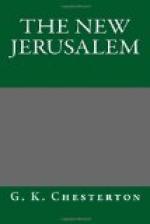I frequently saw old ruined houses of which there only remained two walls of stone, to which the nomads had added two walls of canvas making an exact cube in form with the most startling incongruity in colour. He needs the form and he does not mind the incongruity, nor does he mind the fact that somebody else has done the solid part and he has only done the ramshackle part. You can say that he is nobly superior to jealousy, or that he is without artistic ambition, or that he is too much of a nomad to mind living half in somebody else’s house and half in his own. The real quality is probably too subtle for any simple praise or blame; we can only say that there is in the wandering Moslem a curious kind of limited common sense; which might even be called a short-sighted common sense. But however we define it, that is what can really be traced through Arab conquests and Arab culture in all its ingenuity and insufficiency. That is the note of these nomads in all the things in which they have succeeded and failed. In that sense they are constructive and in that sense unconstructive; in that sense artistic and in that sense inartistic; in that sense practical and in that sense unpractical; in that sense cunning and in that sense innocent. The curtains they would hang round Stonehenge might be of beautifully selected colours. The banners they waved from Stonehenge might be defended with glorious courage and enthusiasm. The prayers they recited in Stonehenge might be essentially worthy of human dignity, and certainly a great improvement on its older associations of human sacrifice. All this is true of Islam and the idolatries and negations are often replaced. But they would not have built Stonehenge; they would scarcely, so to speak, have troubled to lift a stone of Stonehenge. They would not have built Stonehenge; how much less Salisbury or Glastonbury or Lincoln.
That is the element about the Arab influence which makes it, after its ages of supremacy and in a sense of success, remain in a subtle manner superficial. When a man first sees the Eastern deserts, he sees this influence as I first described it, very present and powerful, almost omnipresent and omnipotent. But I fancy that to me and to others it is partly striking only because it is strange. Islam is so different to Christendom that to see it at all is at first like entering a new world. But, in my own case at any rate, as the strange colours became more customary, and especially as I saw more of the established seats of history, the cities and the framework of the different states, I became conscious of something else. It was something underneath, undestroyed and even in a sense unaltered. It was something neither Moslem nor modern; not merely oriental and yet very different from the new occidental nations from which I came. For a long time I could not put a name to this historical atmosphere. Then one day, standing in one of the Greek churches, one




